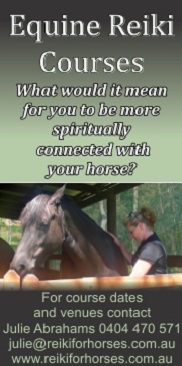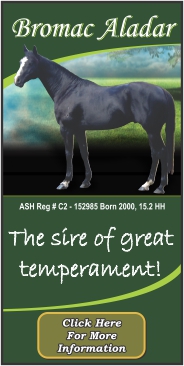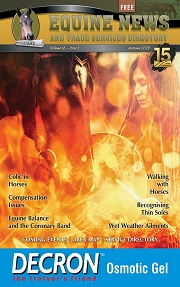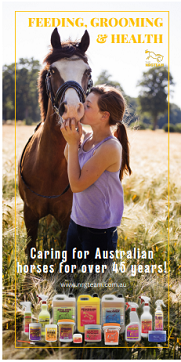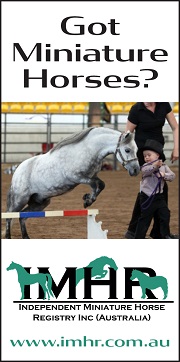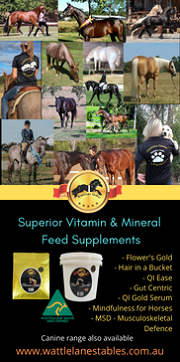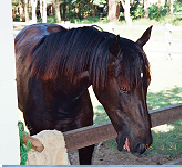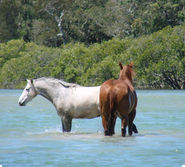By Mel Fleming
Upon a request from a horse owner who had a dangerous and traumatic situation arise with their horse being tied, I was asked to write an article about tying horses. This is a very important subject, as the simple act of tying a horse up, in some cases, can be one of the most dangerous things you could ever do with a horse. A horse’s first instinct is to run when it is feeling endangered and any feelings of being trapped instinctually can send it into panic mode. This makes tying a horse up, one of the most unnatural and terrifying things you could do to him or her. When a horse panics when it is tied, it can become extremely dangerous to itself and anybody around. When a horse is pulling back in fear and full of adrenalin, the power they have is enormous. In this moment when a horse is panic stricken and fighting for it’s life, the horse believes it needs to get away to save its life and it is in no way thinking logically. The horse can panic so extremely when it feels trapped by the “thing “ that has hold of it’s head that it is liable to do itself some very serious injury, even going as far as breaking its neck in the most extreme situation. If a person is standing close to the horse in the moment the horse pulls back then the person is also in danger.
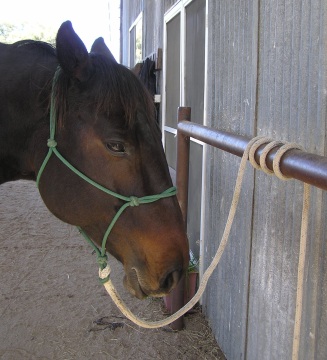
Figure 1 Horse tied by wrapping the rope. Also a very well designed hitching rail, being a good height and the cross rail securely welded. The more wraps the more securely the horse is tied the less wraps the more the rope can release. Be aware though that if the horse pulls at an angle the rope can cross over and lock on itself so it doesn’t release as easily.
The subject of whether to tie horses solid or in a way that they can break free if they really pulled back is one of great debate in the horse world. By tying them solid I mean tying them in a way so that nothing easily gives or breaks if the horse pulls back, as opposed to tying by wrapping around a rail which can give some release or using something breakable like baling twine or tying using a “Tie Blocker Ring” which can be set to release at varying amounts of pressure. Of course you will get extremists who believe that there is only one right way to do things, but I have discovered that things are rarely black or white and usually shades of grey. I use both methods of allowing some release and tying solid depending on the horse and the situation. The important thing is to prepare the horse or check them out before tying them. To make good judgements on the when, where and how of tying horses we need to understand more clearly why horses pull back.
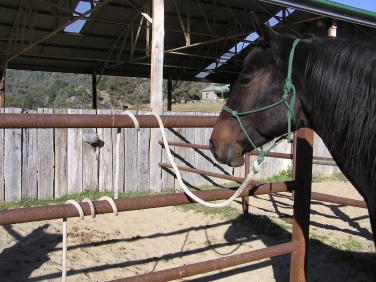
Figure 2 Another way of wrapping. This technique reduces the chance of the rope locking on itself if the horse pulls back on an angle. One wrap is done around the top rail and then the other wraps are around a lower rail.
From my experience horses can pull back for three different reasons:-
Firstly they can panic at the feeling of the strong and ungiving pressure of the halter behind their ears when they move back into this pressure. These horses are afraid of the feeling of the pressure of the halter itself and can be helped by teaching them that the feel of the halter is not going to hurt them – it is not attacking them and if they yield to the pressure, it goes away. After some preparatory ground handling, tying them in a way where the rope can give, release or slip a little can build their confidence.
Others horses pull back because they are scared of ‘things’ around them. For example, a plastic bag flies up near them and they feel they need to get away to save their life. They don’t care how much the halter hurts them or what body parts they break because they are going to die anyway if they don’t get away from the perceived life threatening “thing”. Here as in the above example, they are clearly not thinking, just totally in a reactive survival mode. Tying up is not really their main problem in this case, their problem is that they do not feel safe in the world. Connecting with them and building their confidence in you, themselves and all around them will be the key here, then you could start to tie them with a method that allows some release.
Thirdly, some horses pull back in a much more relaxed manner and they are “thinking” – this is the difference. They have just learned that when they are tied up to something breakable like baling twine, that they can at any time they choose, just leave and wander off. These horses would usually be better to be tied up more solidly, however you might do this gradually because if they are used to breaking away, they could panic when they find that they can’t. For example put more wraps of the rope around the rail or make the thickness of the baling twine more. Like in all situations with horses, we need to look at the emotion underneath the behaviour to determine why the behaviour is happening and therefore have the appropriate approach to correct it.
Guidelines for tying horses safely.
1) Never assume that every horse ties up. A lot of people assume that “tying up” a horse is a stock standard thing that all horses naturally do but that is not the case. It is something that horses have to learn how to deal with. If you are unfamiliar with a horse and do not know whether it ties confidently, you need to go through some preparatory checks (see below) and then tie the horse in a way that allows some release.
2) Never put your fingers through any loops when you are tying the knots – if a horse pulled back just at the right time when your finger was through a loop you could lose a finger or a part of it.
3) Always use a quick release knot if you tie off with a knot rather than wrapping.
4) Tie high – the higher a horse is tied the less leverage or power it can get if it pulls back. The lower it is tied, to the ground for example, the more leverage it will have and therefore the more damage it can do to itself. The most minimal height to tie at would be the point of the horse’s shoulders, but higher than this is better.
5) Tie short – the maximum length that a horse should be tied would be so that it could only just reach it’s nose to the ground and the rope is taught as this happens, but usually it is better to be shorter than this. Any longer than this means that the horse could get its leg over the rope or step on the rope which sends a lot of horses into a panic because their head is now trapped down low. A lot of people think that they are doing their horse a favour by allowing them to graze while being tied – this is very dangerous. DO NOT ALLOW HORSES TO GRAZE WHILE BEING TIED. I have seen horses get wrapped up in their ropes and panic and have had to cut them free. Do not tether unless the horse is very properly prepared. Tying too short can cause horses to feel too trapped and claustrophobic, there should be enough length so that the horse can still lift his head up and turn and look side to side.
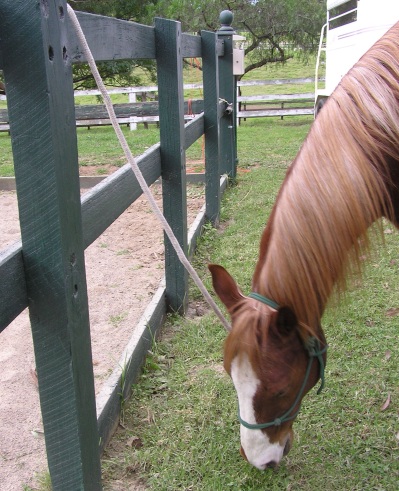
Figure 3 Maximum length to tie a horse.
6.) Tie to a solid object, even if you are tying with string. NEVER tie to a float that is unhooked from a vehicle or a jump wing, or a gate. Check to see that posts you are tying to are solid in the ground and not weak or rotten.
7.) Tie to a post not a rail – If you have the choice between tying to a post or a rail you usually would prefer a post as it is stronger. Rails that are nailed, screwed or wired on are really not very strong when it comes to a horse pulling back and rails are often weaker and may break easily.
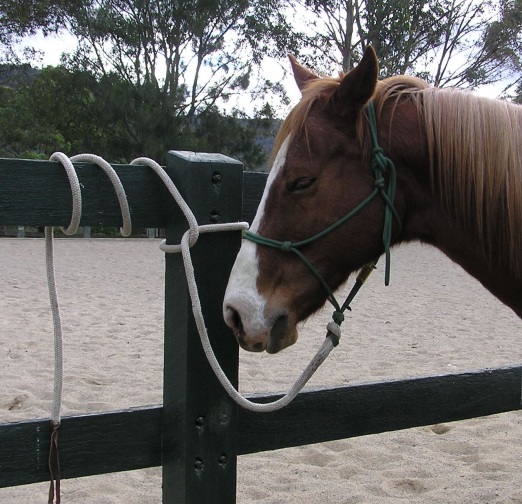
Figure 4 A good way to tie to a post rather than a rail as the pressure is taken on the post not the rail. The wrap around the top rail holds the rope up high and makes it easy to undo. The more wraps the harder it is for the horse to get release.
8.) Don’t tie from reins that are attached to the bit unless you are able to tie the reins up in a way where the pressure will not be on the mouth if the horse did pull back. You could severely injure a horse’s mouth by doing this.
9.) Run the stirrups up the leathers or with stock saddles and western saddles cross the stirrups over the top of the saddle. I have seen horses on a couple of occasions get themselves into a terrible situation when they turned around to bite at a fly and got the stirrup iron caught in their teeth. This is very dangerous if it happens. Some western saddle stirrups are very wide so in these cases it is not a problem as the horses can’t get the side of the stirrup caught in their mouth.
10.) While you are tying the horse or working around a horse that is tied, on the side that you are standing on, keep the horse at a minimum angle of 90 degrees to the rail that it is tied to. This means you are less likely to get trapped between you and the fence if they did pull back.
11.) Make sure that any bridle or hackamore reins are secured out of the way so that the horse can’t put a foot through them or step on them if they lowered their head.
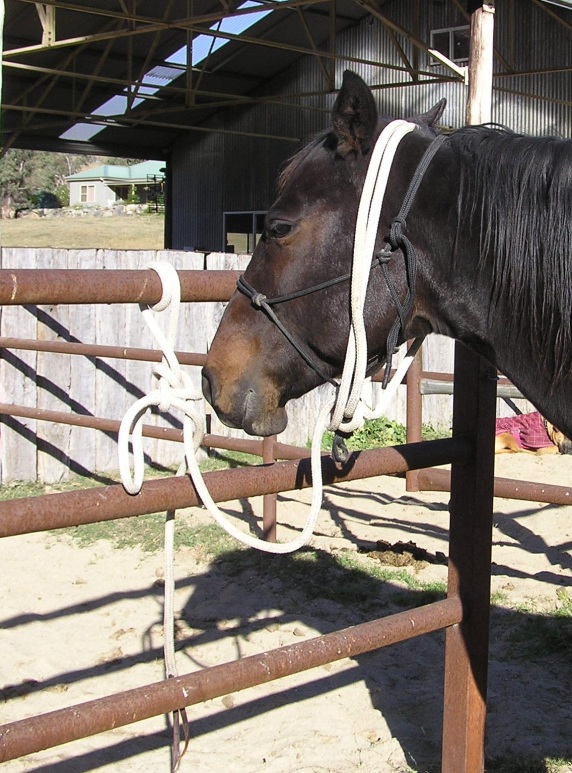
Figure 5 Reins securely and safely tied so that the horse will not be able to step on or through them.
Preparatory checks – If a horse is prepared properly the dangers of tying horses can be avoided.
How well does he/ she follow the feel of the lead rope forward ?
Can you lower the horse’s head with a gentle downward feel of the halter?
Tie the horse with a wrap of the rope around a round rail so that it can slide and release or tie to a piece of string to test how they tie before tying them up solidly.
Of course we could go into much detail here with preparatory checks but that is all we have room for in this article. To summarise don’t make assumptions, be aware and be safe when tying horses.
Mel Fleming

www.melfleming.com.au
mel@melfleming.com.au
0428 385 745








